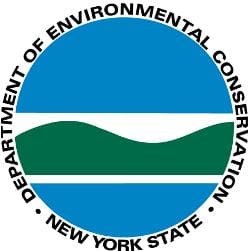New York DEC’S Sturgeon Restoration Efforts Achieve Successful Milestone
OutdoorHub 06.18.12

The state Department of Environmental Conservation (DEC) and its collaborative partners achieved a long-awaited milestone in their efforts to restore lake sturgeon in the Oneida Lake system, the agency announced today. In April a researcher at the U.S. Geological Survey’s Tunison Laboratory of Aquatic Sciences discovered two female lake sturgeon carrying eggs downstream of Oneida Lake. The fish, stocked in Oneida Lake by DEC in 1995 as part of an effort to improve threatened lake sturgeon populations, were the first mature females found since the state restoration work began nearly 20 years ago.
“This is a truly significant event,” said DEC Commissioner Joe Martens. “It is a great example of how, with good science, we can restore a species that nearly disappeared from our state. As part of the state’s restoration program, DEC relies on information we get from anglers as well as sampling by our own staff and partners like USGS and Cornell University to help make intelligent decisions about managing New York’s fish populations.”
Jim Johnson, Director of the USGS Tunison Laboratory of Aquatic Sciences, said, “U.S. Geological Survey staff fulfills its scientific mission by partnering with states in restoration work like this. We are thrilled to be reporting this milestone.”
Equally rewarding was the capture of another egg-bearing female upstream of Black Lake in St. Lawrence County also this past spring. Restoring this species requires patience, since females take 16 to 25 years to mature and breed only an average of once every four years. Male sturgeon take 8 to 16 years to mature and have been caught in Oneida Lake for several years.
Lake sturgeon are the largest fish native to the Great Lakes and can grow up to seven feet in length and may weigh more than 300 pounds. Once abundant throughout the Great Lakes, St. Lawrence River and Lake Champlain, overfishing and the impacts of dams and dredging nearly drove them to extinction by the turn of the 20th century. Sturgeon harvesting, primarily for caviar, peaked in 1885 when more than five tons of sturgeon were taken from Lake Erie alone.
Scientists estimate that sturgeon populations in the Great Lakes area are at about one percent of their pre-1850 numbers. DEC has actively worked with federal and university partners to protect and restore lake sturgeon throughout New York. DEC raised and released lake sturgeon from 1995 to 2006. In 1995, nearly 18,000 sturgeon were released into Oneida, Cayuga and Black lakes and the Oswegatchie River.
In addition to stocked fish, some natural recovery has been observed across the Great Lakes and the St. Lawrence River, where in 2009 lake sturgeon began using spawning beds created by the New York Power Authority.
Anglers across the state have submitted reports of adult sturgeon, including sightings of sturgeon leaping completely out of the water in Fish Creek near Sylvan Beach, a tributary of Oneida Lake. The reports of males in spawning areas coupled with the capture of the mature females gives DEC biologists hope that the sturgeon are successfully spawning. Any young sturgeon produced this spring should be large enough to be caught in nets set by scientists in a few years.
For more information on New York’s sturgeon, visit the Fisheries page on the DEC website at http://www.dec.ny.gov/animals/7025.html.

